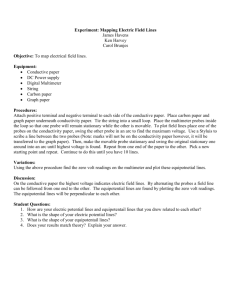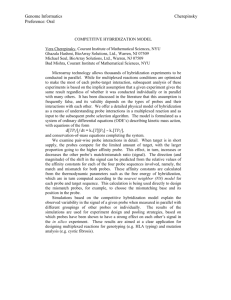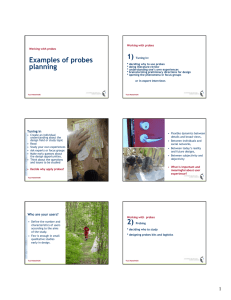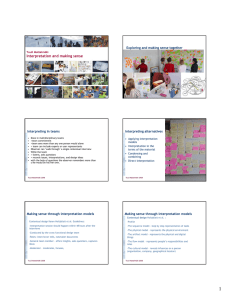Attitude Iterative process Methods
advertisement
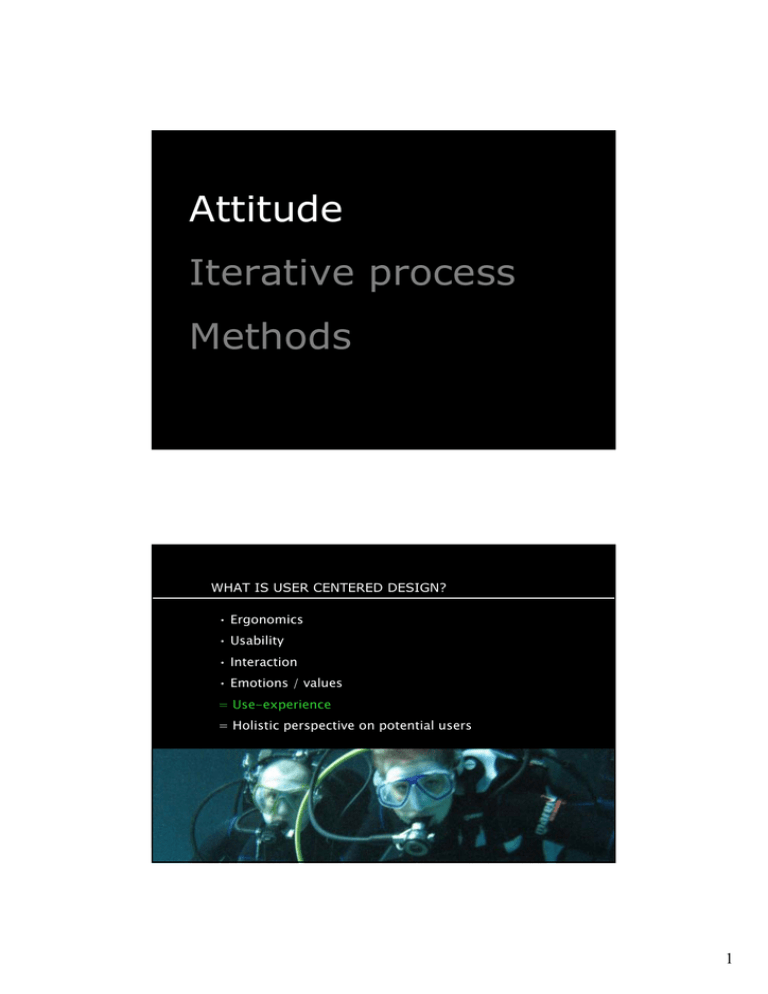
Attitude Iterative process Methods WHAT IS USER CENTERED DESIGN? • Ergonomics • Usability • Interaction • Emotions / values = Use-experience = Holistic perspective on potential users 1 APPROACHING THE USE-EXPERIENCE • What people are doing? • Who? • Where and When? • Why and How? • Needs, Values, Lifestyle? • Alone or Together? WHAT KIND OF INFORMATION IS NEEDED? KNOWLEDGE: WHAT PEOPLE: SAY THINK SAY EXPLICIT OBSERVABLE DO USE Observation DO TACIT KNOW FEEL DREAM Interview MAKE LATENT (Sanders & Dandavate, 1999*) Generative methods: Probes, collages, codesign workshops, design games *Sanders, E. B.-N, Dandavate, U (1999). Design for experiencing: New tools. Paper presented to the First International Conference on Design and Emotion. Delft University of Technology, Delft, The Netherlands 2 Kirsikka Vaajakallio 19.03.2009 Design probes A) Seeking experiences and design empathy: Why? B) Approaching experiences: How? C) Probing examples; Cultural and Emphatic Probes *presentation is partly based on Eva Brandt’s and Tuuli Mattelmäki’s material Why? We need user data from places and situations where researchers or designers presence would be disturbing. We need to understand emotional and subjective perspectives, attitudes and meanings. How to document experiences which take place in private contexts? How to support people to document their everyday experiences, values and needs? 3 How? Probes • Based on self-documenting. • Collections of tasks, which are given to people to make them analyze, document and express their experiences and ideas. • Focus on the users’ subjective world. • Design oriented. Use your skills!! • Empower both users’ and designers’ interpretations and creativity. Bille Gaver and Tony Dunne Royal College of Art, London Cultural Probes CHI’99, Pittsburgh. ACM: New York The Bijlmer housing district, Amsterdam: • Poor reputation • Unemployment • Drug abuse • Crime 4 Project goals To find new ideas for using new media in order to support elderly peoples’ active presence in local communities. Characteristics: • Address people’s emotional, aesthetic, and experimental reactions to their environments. • Look for alternative future. • Provoking and visual, not for analyses but to inspire creative thinking. .... ”if Bijlmer were a body ...” Probe materials – postcards • Strong, ambiguous and contradicting images with text. • To evoke stories from experiences. ...”tell us a piece of advice” ... ”why do we have politicians?” 5 Probe materials – camera tasks ... ”what will you wear today?” ...”something beautiful” ... ”something ugly” Send us 6-10 pictures that tell us your story! Mattelmäki & Battarbee 2002 Mattelmäki 2003 Mattelmäki 2006 Empathy probes The main interest has been in gathering empathic versatile subjective user data for concept design. reminder camera stickers • Company collaboration. • Following interviews support interpretations. My weaknesses Diary / task book postcards My strengths 6 (Picture by Tuuli Mattelmäki) Reasons for applying probes Probing process (Picture by Tuuli Mattelmäki) 7 Example: Active@work project • Was carried out by University of Art and Design Helsinki. • Aim was to develop alternative concept solutions for ageing workers well being at work. • Focused on individual workers and their motivations, problems and attitudes. • Alltogether 15 workers, 8 from cleaning maintenance (all female) and 7 from technical maintenance (all male), participated in the probe study. Probing process – example from Active@work project Interpretation Interviews Producing the probes Probes are in the field Planning 8 Work book / diary Map Probe Design • Should be communicative, visual and motivating. • Illustrations can help in understanding the questions and stimulate emotional responses. • Appropriate for the topic and the users. • Can reflect designer’s view about the research and design issues • Consider the logistics, time and broadness. • What you want to find out? • Individual / group work. Timetable Postcards Disposable camera Stickers or other ’ready made’ material can inspire and support filling the probe Designing the probe kit • In the brainstorming session the researchers created ideas about themes, open questions, tasks and the form of the probe package. 9 selfdocumentation Content • • • • Instructions A disposable camera A one week timetable task 2 postcards, one of which was addressed to Palmia and the other was addressed to the researchers at the University of Art and Design Helsinki • A booklet which included questions and tasks grouped into different themes • A map in which the users were told to keep track of their movements during a working day Rewarding my self 10 Content: The booklet Who am I? • Describe your personality. • Continue the sentence: The best thing when getting older is... • Continue the clause: The worst thing when getting older is... The aim: • To get an idea what ageing means to them and find out about who they are as individuals. Content: The booklet Who am I? • If you would be a shoe what kind of shoe you would be and why? The aim: • With an abstract question something inspirational and unexpected things can be revealed. 11 Content: The booklet Social connections • Tell with this picture about your social network. Who do you meet and keep in touch with? Think it both from your work community and leisure point of view. The aim: • To get an idea of the amount and importance of their social contacts. Content: The booklet Physical wellbeing • Mark with stickers those areas of body which strain during the work day. Tell when and why it happens and how it could be prevented. The aim: • To get an idea what physical problems individuals have. 12 Content: The booklet ”recipe of nice work day” • What elements create a nice work day. What are the main ”ingredients” and what are the small but important ”spices” which crowns the day. Think also what can spoil it? The aim: • To get insights of the importance of the atmosphere at workplaces and its meaning for wellbeing. Content: The booklet Physical environment • Here are some pictures about old tools. Tell or draw what kind of tool could help you in your work in the future. The aim: • To get first impression about the possibilities of developing better tools for them. 13 Content: Map + Timetable The map aim: • To get an overview of different environments and physical spaces during the week or day. The timetable aim: • To get an overview of the weakly tasks and routines. Wednesday Thursday Content: The postcard • The postcard had an open aim. Translation: “To bow is not bad if you bow in a right place” 14 The tool I like most… Content – camera tasks • For visualizing the context Mechanics I confront in my work… This is hard… Interviews Discussing the returned probes material and the taken photographs. Interview complements the fragmented probes data. After receiving the probes researchers go through it and makes structure for the interview. 15 Collages • Can reveal values, attitudes and dreams difficult to verbalise. • Can include words and images. • How they organise the images, what images they use and what they tell is interesting. (ask people to think aloud) Data 16 Interpreting and making sense • Applying interpretation models e.g. Affinity diagram. • Interpretation in the terms of the material. >> Leave your pre image behind and start with an open mind!!! • Condensing and combining. • Direct interpretation. Probe study results • Combine and condense it into visual and narrative presentations. • Illustrates your findings in inspiring way. • Support the overall topic • Poster, booklet, web page ,… >>> think your audience 17 Combine and condense: User descriptions • Represent individual characters and interpretations (without revealing the person). • Not caricature or it looses credibility. • Summarize characteristics, tasks, attitudes etc. • Support insights and facilitate collaboration. • Create base for brainstorming, developing and evaluating concept design solutions. What next? • Idea generation based on persona descriptions. • Finding focus for concept development. tion l educa dividua in , y g lo no ile tech ls, mob ent, too m n o ir v En Deciding focus Co-design workshop using persona descriptions 18 What next? • More user studies, workshops, generative methods… • Persona descriptions helped to: a) Remember the users; b) Form design drivers according to different motivations; c) Present the concept ideas through them. Probe assignment Think: • Who are your users? *Define the number and characteristics of users according to the aims of the study. • What you want to find out? *Plan the content based on that. • How you can apply different tasks? 19


